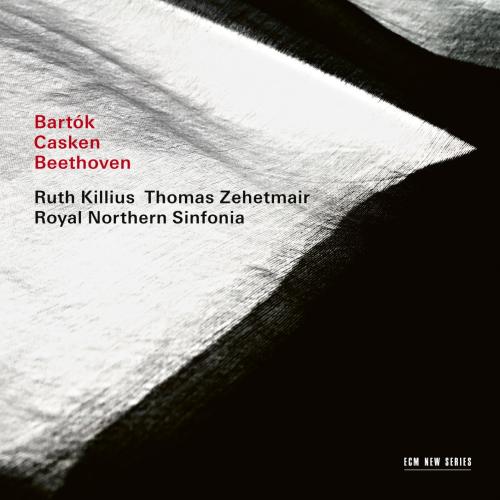
Bartók / Casken / Beethoven Ruth Killius, Thomas Zehetmair, Royal Northern Sinfonia
Album info
Album-Release:
2023
HRA-Release:
17.02.2023
Label: ECM New Series
Genre: Classical
Subgenre: Orchestral
Artist: Ruth Killius, Thomas Zehetmair, Royal Northern Sinfonia
Composer: Bella Bartók (1881-1945), John Casken (1949), Ludwig van Beethoven (1770–1827)
Album including Album cover Booklet (PDF)
I`m sorry!
Dear HIGHRESAUDIO Visitor,
due to territorial constraints and also different releases dates in each country you currently can`t purchase this album. We are updating our release dates twice a week. So, please feel free to check from time-to-time, if the album is available for your country.
We suggest, that you bookmark the album and use our Short List function.
Thank you for your understanding and patience.
Yours sincerely, HIGHRESAUDIO
- John Casken (b. 1949): That Subtle Knot:
- 1 Casken: That Subtle Knot: I. Calm 15:21
- 2 Casken: That Subtle Knot: II. Floating 11:15
- Béla Bartók (1881 - 1945): Viola Concerto, Sz. 120:
- 3 Bartók: Viola Concerto, Sz. 120: I. Moderato (Compl. Serly) 13:27
- 4 Bartók: Viola Concerto, Sz. 120: II. Adagio religioso - Allegretto (Compl. Serly) 03:47
- 5 Bartók: Viola Concerto, Sz. 120: III. Allegro vivace (Compl. Serly) 04:36
- Ludwig van Beethoven (1770 - 1827): Symphony No. 5 in C Minor, Op. 67:
- 6 Beethoven: Symphony No. 5 in C Minor, Op. 67: I. Allegro con brio 06:49
- 7 Beethoven: Symphony No. 5 in C Minor, Op. 67: II. Andante con moto 08:19
- 8 Beethoven: Symphony No. 5 in C Minor, Op. 67: III. Scherzo. Allegro - Trio 04:47
- 9 Beethoven: Symphony No. 5 in C Minor, Op. 67: IV. Allegro 10:33
Info for Bartók / Casken / Beethoven
This powerful New Series album represents “a résumé and a departure” for Thomas Zehetmair, a summing up of his work with the Royal Northern Sinfonia. In his years as Music Director of the British chamber orchestra, Zehetmair was noted both for bringing compelling new music into the repertoire and for insightful performances of classical and modern composition, qualities very much in evidence on this concert recording from The Sage, Gateshead. The album opens with John Casken’s double concerto That Subtle Knot, written in 2012-3 for Zehetmair, Ruth Killius and the Northern Sinfonia. Inspired by the poetry of John Donne, the composition establishes a broad arc between the English Renaissance and music of today. Ruth Killius shines in a revelatory performance of Bartók’s Viola Concerto, and Zehetmair as conductor fully brings out what liner note writer Giselher Schubert describes as “the juggernaut propulsive thrust” of Beethoven’s Symphony No. 5.
The album includes the premiere recording of British composer John Casken’s That Subtle Knot, written in 2012-3 for Zehetmair, Ruth Killius and the Northern Sinfonia. Inspired by the poetry of John Donne, the composition establishes a broad arc between the English Renaissance and music of today, paints portraits of the dedicatees, and draws influence, too, from the rugged landscapes of the North of England. The title of the piece comes from Donne’s poem The Ecstasy. The poem focuses upon two lovers sitting on a riverbank, hands entwined: “Our eye beams twisted and did thread / Our eyes upon one double string.” The image seemed to John Casken perfect for a double concerto for viola and violin.
Ruth Killius opens the piece, with solo viola played “as if recalling an old folk song”, and the entrance of independent part-writing for the violin begins a process in which two strong and independent characters explore a changing musical universe together. Ruth Killius also shines in Bartók’s Viola Concerto, one of the last pieces written by the Hungarian composer. As Colin Anderson wrote in online magazine Classical Source, “Ruth Killius really brought the music alive, finding rustic vitality and deep nostalgia in the romantic and rhapsodic first movement.”
And Zehetmair as conductor fully brings out what liner note writer Giselher Schubert describes as “the juggernaut propulsive thrust” of Beethoven’s Symphony No. 5. In a five star review of the live event Guardian critic Alfred Hickling wrote “For his final concert as music director of the Royal Northern Sinfonia, Thomas Zehetmair decided to go out with a bang. Four very loud, extremely rapid bangs to be specific, as he launched into a valedictory version of Beethoven’s Fifth Symphony with an attack so urgent and incisive that it sounded less like destiny hammering at the door than destiny forcing an entrance with emergency equipment. It’s testimony to Zehetmair’s mercurial talent that he’s capable of springing these surprises even in the most familiar repertoire.”
Thomas Zehetmair: “Beethoven’s Fifth is unquestionably a milestone in the symphonic literature. And It occupied a special place in my work with the Royal Northern Sinfonia, whether on our tours or as the climax of a Beethoven cycle.”
Thomas Zehetmair, violin, conductor
Ruth Killius, viola
Royal Northern Sinfonia
Thomas Zehetmair
That notion of immersion, of deep engagement with the music, runs like a thread through Thomas Zehetmair’s distinguished and unusually varied musical career as soloist, quartet leader, and conductor. Zehetmair was born in Salzburg in 1961 and has an association with ECM dating back to his early twenties. In his recordings, he has explored some of the peaks of the solo violin repertoire (Paganini’s 24 caprices and Eugène Ysaÿe’s solo sonatas), duets (with violist Ruth Killius, on “Manto and Madrigals”) and, as soloist and conductor, repertoire that includes Bartók, Schoenberg, Veress, and Heinz Holliger. Zehetmair has spoken of virtuosity not as an end in itself but a means to an end: a mastery of all the expressive possibilities that enables access to “the purpose and relationship of every single note in the overall musical architecture”.
"As a listener I want to immerse myself in music, understand its structure and be moved by the beauty of its proportions and the richness of its passions.”
The eponymous Zehetmair Quartet, founded in 1994, bring an almost improvisational quality to the repertoire they play; the fact that their performances are given from memory means they sparkle with the freshness of new discoveries. Their recording of Robert Schumann’s string quartets nos. 1 and 3 was described as “revelatory” by Gramophone magazine, which praised its eschewal of surface gloss in favour of uncovering these works’ profound beauty. That disc won Gramophone Record of the Year in 2003. The Zehetmair Quartet has looked afresh at other monuments of the string quartet repertoire and also made an eloquent case for less familiar masterpieces by composers such as Hartmann, Hindemith, and even Bruckner, as well as producing the first recording of Heinz Holliger’s string quartet, which Zehetmair has called “an explosion of fantasy”.
Booklet for Bartók / Casken / Beethoven









